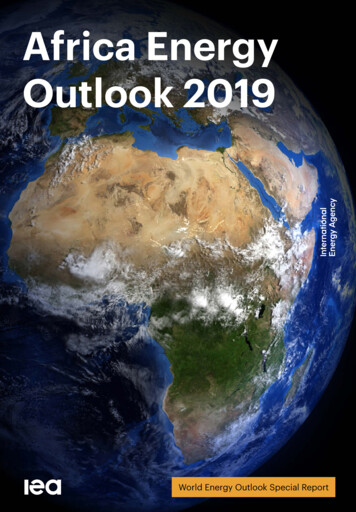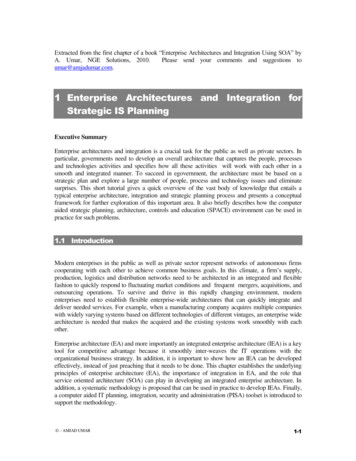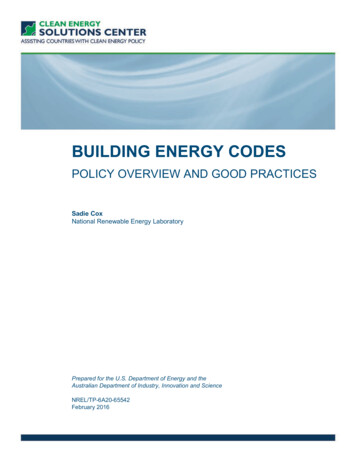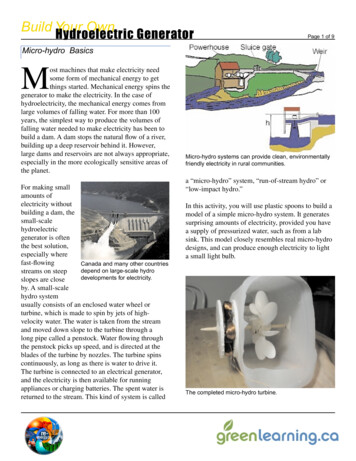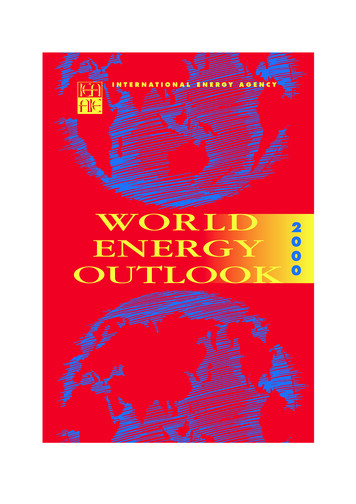
Transcription
WeoFull200016/10/0010:13Page 1INTERNATIONALE N E RGYAGENCYWOR LDENERGYOUTLOOK2000
INTERNATIONALE N E RGY A G E N C YWOR LDENERGYOUTLOOK2000
FOREWORDThe World Energy Outlook has become the authoritative source for energyprojections of the world’s energy future. This 2000 edition examines energydemand and supply for 13 world regions to 2020. It draws the implications ofthese projections for international trade, energy-related CO2 emissions andinvestment requirements in power generation.The study does not try to predict the future, but to identify and analyse keyfactors in global energy over the next two decades. Its projections are derivedfrom a “Reference Scenario”, which incorporates the new policies and measuresenacted in OECD countries in order to meet their commitments under theKyoto Protocol, as well as some other measures which also reduce CO2 emissions.Previous editions of the Outlook used a “business-as-usual” approach, whichposited a world where no new energy and climate policies were introduced. TheIEA’s World Energy Model — the tool for generating the projections — has beenenhanced to include separate models for Russia, India and Brazil.We project continuing steady growth in world energy use and in relatedCO2 emissions, despite the recent efforts by many OECD countries to mitigateunwanted climate change. Our findings describe the extent of the challenge.Fossil fuels will continue to dominate the world energy mix. OECDcountries’ share of world energy demand will continue to decline in favour ofnon-OECD countries. Consuming regions, including the OECD and thedynamic Asian economies, will become much more dependent on imported oiland gas. As demand grows, massive investment in oil production facilities willbe needed, particularly in the Middle East. Large investments in electricitygeneration, in particular in developing countries, will also be required.We have developed three “alternative cases” to the Reference Scenario. Inone, we measure the extent to which an international market for CO2 emissionreductions could reduce the costs of meeting the Kyoto targets. A secondalternative examines the transport sector and points to the need for a packageof measures to limit CO2 emissions in OECD countries. A third casedemonstrates the scope that exists for mitigating rising CO2 emissions inOECD countries by switching to natural gas and renewables, extending thelives of existing nuclear plants, and boosting the role of combined heat andpower technologies.This work is published under my authority as Executive Director of theIEA and does not necessarily reflect the views or policies of the IEA Membercountries.Robert PriddleExecutive DirectorForeword3
Comments and questions are welcome and should be addressed asfollows:Fatih BirolHead, Economic Analysis DivisionInternational Energy Agency9, rue de la Federation75739 Paris Cedex 15FranceTelephone: (33-1) 4057 6670Fax.:(33-1) 4057 6659E-mail:Fatih.Birol@iea.org4World Energy Outlook 2000
ACKNOWLEDGEMENTSThis Outlook was prepared by the Economic Analysis Division (EAD)of the IEA. The Director of the Long-Term Office, Olivier Appert,provided guidance and encouragement throughout the project. The studywas designed and managed by Fatih Birol, Head of the Economic AnalysisDivision. Other members of the EAD who were responsible for bringingthis study to completion include: Maria Argiri, François Cattier, LauraCozzi, Sandrine Duchesne, Jan Keppler, Atsuhito Kurozumi, TeresaMalyshev and Alison Sadin. Many colleagues from other IEA Divisionsmade important contributions: Michael Landwehr (lead author forAlternative Transportation Case), Céline Marie-Lilliu (AlternativeTransportation Case), Fridtjof Unander (Alternative Power GenerationCase-fossil fuel section), John Paffenbarger (Alternative Power GenerationCase-nuclear power section), Isabel Murray (co-author Russia Chapter),Mike Wittner (oil supply), Alessandro Lanza (emission trading modelling)and Pierre Audinet (input to India chapter).The study also benefited from the comments and suggestions of otherIEA colleagues. These include: Richard Baron, John Cameron, XavierChen, Carmen Difiglio, Peter Fraser, Miharu Kanai, Sohbet Karbuz, HansKausch, David Knapp, Sylvie Lambert D’Apote, Lawrence Metzroth,Hanns Neef, Hans Nilsson, Jonathan Pershing, Rick Sellers, KarenTreanton, François Verneyre, Maria Virdis and Deborah White. Twoindependent consultants made valuable contributions, Robert Cornell andTrevor Morgan.In producing this work, discussions were held with a wide range ofexperts outside the IEA. They include many officials of Member and nonMember governments and representatives of international organizationsand research institutes around the world. We attempt to acknowledge allthose contributions on the next page, and we apologize if we haveinadvertently left anyone off the list.Of course, all errors and omissions are solely the responsibility of theauthors.Acknowledgements5
Acknowledgement of Experts outside of the IEATom Ahlbrandt, United States Geological Survey, Colorado, USAPaul Atkinson, OECD Economics Department, Paris, FranceJean-Marc Burnieaux, OECD Economics Department, Paris, FranceJack Cadogan, United States Department of Energy, Washington DC, USAPantelis Capros, National Technical University of Athens, Athens, GreeceDavid Chien, United States Department of Energy, Washington DC, USAPatrick Criqui, Institut d’Economie et Politique de l’Energie, Grenoble,FranceManfred Decker, European Commission, DG TREN, Brussels, BelgiumDenny Ellerman, Massachusetts Institute of Technology, Massachusetts,USAJane Ellis, OECD Environment DirectorateSujata Gupta, Tata Energy Research Institute, New Delhi, IndiaNadir Gurer, Organisation of Petroleum Exporting Countries, Vienna,AustriaMary Hutzler, United States Department of Energy, Washington DC, USAYonghun Jung, Asia Pacific Energy Research Centre, Tokyo, JapanKazunari Kainou, Ministry of International Trade and Industry, Tokyo,JapanNina Kousnetzoff, Centre d’Etudes Prospectives et d’InformationsInternationales, Paris, FranceCatherine Locatelli, Institut d’Economie et Politique de l’Energie,Grenoble, FranceDavid McNabb, Natural Resources Canada, Ottawa, CanadaJohn Mitchell, Royal Institute of International Affairs, London, UnitedKingdomEdmilson Moutinho dos Santos, University of Sao Paulo, Sao Paulo, BrazilK.Y. Nam, International Atomic Energy Agency, Vienna, AustriaMarcelo Khaled Poppe, Agencia Nacional de Energia Eletrica, Brasilia, BrazilJohn Hugh Rees, European Commission, DG TREN, Brussels, BelgiumJi-Chul Ryu, Korea Energy Economics Institute, Seoul, Republic of KoreaKaren Schneider, Australian Bureau of Agricultural and ResourceEconomics, Canberra, Australia6World Energy Outlook 2000
Leo Schrattenholzer, International Institute for Applied Systems Analysis,Laxenburg, AustriaOleg A. Sinyugin, Moscow State University, Moscow, RussiaJeff Skeer, United States Department of Energy, Washington DC, USALakis Vouyoukas, Freelance Energy Consultant, Athens, GreeceZhongan Wang, State Planning and Development Commission, Beijing,ChinaKeith Welham, Rio Tinto plc., London, United KingdomPeter Wiederkehr, OECD Environment Directorate, Paris, FrancePeter Wilmer, OECD Nuclear Energy Agency, Paris, FranceYukari Yamashita, Institute of Energy Economics of Japan, Tokyo, JapanKeiichi Yokobori, Asia Pacific Energy Research Centre, Tokyo, JapanAcknowledgements7
TABLE OF CONTENTSPageForewordAcknowledgementsTable of ContentsList of Figures in TextList of Tables in TextExecutive Summary359121621PART A: Global Trends to 20203133334144474760647171849195Chapter 123The ContextKey AssumptionsThe Reference Scenario and Alternative CasesMajor UncertaintiesWorld Energy TrendsPrimary Energy DemandFinal Energy DemandThe Environmental ImplicationsThe Energy Market OutlookOil Market OutlookGas Market OutlookCoal Market OutlookPower GenerationPART B: Regional Outlooks to 2020Chapter 45Table of ContentsOECD North AmericaIntroductionMacroeconomic BackgroundRecent Energy-Sector DevelopmentsAssumptionsResults of the ProjectionsOECD EuropeIntroductionMacroeconomic BackgroundRecent Energy-Sector DevelopmentsAssumptionsResults of the 9
6789OECD PacificIntroductionMacroeconomic BackgroundRecent Energy-Sector DevelopmentsAssumptionsResults of the ProjectionsRussiaIntroductionMacroeconomic BackgroundRecent Energy-Sector DevelopmentsAssumptionsResults of the ProjectionsEnvironmental IssuesChinaIntroductionMacroeconomic BackgroundRecent Energy-Sector DevelopmentsAssumptionsResults of the ProjectionsEnvironmental IssuesBrazilIntroductionMacroeconomic BackgroundRecent Energy-Sector DevelopmentsAssumptionsResults of the ProjectionsEnvironmental IssuesPART C: Special Issues Arising from the OutlookChapter 1010Greenhouse-Gas Emission TradingIntroductionThe Kyoto Protocol and Its Three Dimensionsof FlexibilityCarbon Dioxide Emissions and EnergyConsumptionThe Case for TradingThe ResultsWhat the Others Are DoingConclusions and Policy 27228230232235242244World Energy Outlook 2000
11121314The Alternative Transportation CaseIntroductionTransport Energy Demand Trendsin the Reference ScenarioThe Alternative CaseConclusionsThe Alternative Power Generation CaseIntroductionFossil FuelsNuclear PowerRenewablesCombined Heat and Power Plants (CHP)Summary of Results and ConclusionsIndia: An In-depth StudyIntroductionMajor Issues and UncertaintiesMacroeconomic BackgroundRecent Energy-Sector DevelopmentsAssumptionsResults of the ProjectionsSupply ProspectsEnvironmental IssuesAssessment of Past WEO ProjectionsProjections and the World Energy ModelBrief Description of Past WEOsExogenous Variables in the WEOEvaluation of ProjectionsComparisons with Other Energy OutlooksWhat Have We Learned?PART D: Tables for Reference Scenario ProjectionsEconomic Growth and Population AssumptionsSupplementary Tables for Energy Demand,Power Generation and CO2 EmissionsAppendix 1 Description of the World Energy Model2 Comparison of WEO 2000 Projectionswith Other Studies3 Definitions and Conversion FactorsList of Abbreviations and AcronymsBibliographyTable of 441943144144744911
List of Figures in TextPageChapter 1:Figure 1.1:Figure 1.2:Figure 1.3:Figure 1.4:Figure 1.5:The ContextWorld TPES vs. GDP, 1971-1997Regional Shares in World GDPPer Capita Income by RegionAssumptions for World Fossil Fuel PricesCapital-Stock TurnoverChapter 2:Figure 2.1:Figure 2.2:Figure 2.3:Figure 2.4:Figure 2.5:World Energy TrendsWorld Primary Energy Supply by Fuel, 1971-2020World Primary Energy Supply by RegionWorld and OECD Energy-Related ServicesWorld Primary Energy IntensityShare of CRW in Total Final Consumptionvs. Per Capita GDP, 1971-2020Figure 2.6: Fuel Shares in World Total Final ConsumptionFigure 2.7: Share of Electricity in Non-Transport FinalConsumptionFigure 2.8: Houshold Electricity Prices vs. Electricity Intensity,1997Figure 2.9: Per Capita Electricity Consumption in the OECDand Developing CountriesFigure 2.10: Average Annual Growth Rate in World TPESand CO2 EmissionsFigure 2.11: Per Capita CO2 Emissions by RegionFigure 2.12: CO2 Emissions per kWh in the OECD RegionsChapter 3: The Energy Market OutlookFigure 3.1: Total World Primary Oil Demand by RegionFigure 3.2: Incremental Oil Demand by Sector, 1997-2020Figure 3.3: Per Capita Oil Consumption vs. Per Capita GDP,1971-2020Figure 3.4: World Crude Oil and NGL ReservesFigure 3.5: World Incremental Oil ProductionFigure 3.6: Natural Gas Reserves by RegionFigure 3.7: Gas Production by RegionFigure 3.8: Regional Breakdown of Incremental World CoalDemand, 37682869092World Energy Outlook 2000
Figure 3.9: World Electricity Generation, 1971-2020Figure 3.10: Changes in OECD Nuclear CapacityFigure 3.11: Wind-Power Capacity in OECD EuropeChapter 4:Figure 4.1:Figure 4.2:Figure 4.3:Figure 4.4:Figure 4.5:Figure 4.6:Figure 4.7:Figure 4.8:Figure 4.9:OECD North AmericaRetail Gasoline Prices in Selected OECD Countries,1999OECD North America Total Primary Energy SupplyFinal Energy Consumption by SectorChange in Energy-related CO2 Emissions by Sectorand Fuel, 1997-2020Incremental Oil Consumption by SectorOECD North America Oil BalanceOECD North America Gas BalanceOECD North America Electricity GenerationComparison of Current Generating Costsof New Steam Coal and CCGT Plants in OECDNorth AmericaOECD EuropeGDP Per Capita in OECD Europe Countries,1998Figure 5.2: OECD Europe Total Primary Energy SupplyFigure 5.3: Breakdown of OECD Europe TPES by FuelFigure 5.4: Final Energy Consumption by SectorFigure 5.5: OECD Europe CO2 Emissions by SectorFigure 5.6: OECD Europe Oil BalanceFigure 5.7: OECD Europe Total Oil Imports by Source, 1999Figure 5.8: OECD Europe Gas BalanceFigure 5.9: OECD Europe Net Imports of Gas by OriginFigure 5.10: Electricity Generation in OECD Europe96100102112119122123124125126128130Chapter 5:Figure 5.1:Chapter 6:Figure 6.1:Figure 6.2:Figure 6.3:Figure 6.4:Figure 6.5:Figure 6.6:Figure 6.7:OECD PacificJapan’s Dependence on External Energy Sources,1998Total Primary Energy Supply, OECD PacificEnergy Intensity in OECD PacificFinal Energy Consumption by SectorOECD Pacific Oil SupplyOECD Pacific Gas BalanceElectricity Generation, OECD PacificList of Figures in 6516813
Chapter 7:Figure 7.1:Figure 7.2:Figure 7.3:Figure 7.4:Figure 7.5:RussiaEnergy Indicators, CO2 Emissions and GDPTotal Primary Energy SupplyTotal Final ConsumptionFinal Oil Consumption by SectorRussian Oil BalanceChapter 8:Figure 8.1:Figure 8.2:Figure 8.3:Figure 8.4:Figure 8.5:ChinaEnergy Intensity in China, OECD and IndiaBreakdown by Region of Incremental WorldPrimary Energy Demand, 1997-2020Total Primary Energy Supply by FuelTotal Final Energy Consumption by SectorOil Balance in China195196197199Chapter 9:Figure 9.1:Figure 9.2:Figure 9.3:BrazilTotal Primary Energy Supply by FuelOil Demand by SectorOil Balance in Brazil214215216Chapter 10: Greenhouse-Gas Emission TradingFigure 10.1: Marginal Abatement Cost Curves for the FiveTrading RegionsChapter 11: The Alternative Transportation CaseFigure 11.1: Share of Transport Sector in OECD PrimaryOil DemandFigure 11.2: Transportation Activity and Modal Mixin the Reference ScenarioFigure 11.3: Passenger Vehicle Ownership vs. GDPPer CapitaFigure 11.4: Transport-Energy Demand and CO2 Emissionsin the Reference ScenarioFigure 11.5: Fuel Intensity for New Passenger VehiclesFigure 11.6: Fuel Intensities in Western Europe, 2020Figure 11.7: Energy Demand and CO2 Emissionsin the Alternative Case, Comparedwith the Reference ScenarioFigure 11.8: Modal Allocation of Growth in Transport-EnergyDemand in the Past, the Reference Scenarioand the Alternative 4World Energy Outlook 2000
Chapter 12: The Alternative Power-Generation CaseFigure 12.1: Alternative Power-Generation Case: CO2 Emissionsper Unit of Electricity Generated, for VariousFossil-Fuel Generation Alternatives in 2020Figure 12.2: Changes in CO2 per kWh Generated from FossilFuelsChapter 13:Figure 13.1:Figure 13.2:Figure 13.3:Figure 13.4:Figure 13.5:Figure 13.6:India: An In-depth StudyIndia’s Extremely Low Per Capita Indicators, 1997Total Primary Energy SupplyIncremental Primary Energy Demand by FuelHousehold Fuel Use across Income ClassesShare of CRW in Total Primary Energy SupplyPrimary Energy Intensity Includingand Excluding CRWFigure 13.7: Oil Balance in IndiaFigure 13.8: Incremental CO2 Emissions by Sector, 1997-2020280285306315316322323324325331Chapter 14: Assessment of Past WEO ProjectionsFigure 14.1: Oil Price AssumptionsFigure 14.2: WEO Deviations from Current Data for OECDEnergy Demand in 2000Figure 14.3: WEO Deviations from Estimated World-OilDemand in 2000Figure 14.4: Comparison of 1993 Projections of Average AnnualGrowth in OECD Total Primary Energy Demand,1990 to 2000346Appendix 1:Figure A1.1:Figure A1.2:Figure A1.3:Figure A1.4:Figure A1.5:Figure A1.6:Figure A1.7:420421423424426427428World Energy Model DescriptionWorld Energy Model OverviewWEM RegionsStructure of the Final Energy Demand ModulePower Generation ModuleStructure of Oil Supply Sub-ModuleEmission Trading ModuleStructure of the Transportation ModuleAppendix 2: Comparison of WEO 2000 Projectionswith Other StudiesFigure A2.1: Comparison of Middle East OPEC Sharesin World Oil ProductionList of Figures in Text33934034243315
List of Tables in TextPageChapter 1:Table 1.1:Chapter 2:Table 2.1:Table 2.2:Table 2.3:Table 2.4:Table 2.5:The ContextAssumptions for World FossilFuel Prices39World Energy TrendsWorld Coal Consumption by RegionTPES in Developing CountriesWorld Total Final ConsumptionGlobal CO2 Emissions by Region and by SectorCO2 Emissions and Targets in Annex B Countries,2010Chapter 3:Table 3.1:Table 3.2:Table 3.3:Table 3.4:Table 3.5:Table 3.6:Table 3.7:Table 3.8:Table 3.9:The Energy Market OutlookWorld Oil BalanceProjected Net Oil Imports and ExportsOil Import DependenceTotal World Primary Supply of GasUSGS Global Gas Resource EstimatesGas Import DependenceWorld Coal Consumption by RegionNuclear Capacity by RegionRenewables Capacity and Electricity Generationby RegionTable 3.10: World Power-Capacity Requirements by RegionTable 3.11: World Investment in New Capacity by RegionChapter 4:Table 4.1:Table 4.2:Table 4.3:Chapter 5:Table 5.1:Table 5.2:1654596166707783848588909199103106107OECD North AmericaOECD North America Reference-ScenarioAssumptionsTotal Final Energy ConsumptionElectricity-Generating Capacity by Fuel118121129OECD EuropeElectricity and Gas Prices in Selected EuropeanCountriesOECD Europe Reference-Scenario Assumptions136137World Energy Outlook 2000
Table 5.3:Chapter 6:Table 6.1:Table 6.2:Table 6.3:Table 6.4:Table 6.5:Table 6.6:Gasoline and Diesel Prices and Taxes in SelectedEuropean Countries, 1999OECD PacificKey Energy Indicators of OECD Pacific Countries,1998OECD Pacific Reference-Scenario AssumptionsTotal Primary Energy SupplyTotal Final ConsumptionOECD Pacific Net Oil Imports by Country, 1999Electricity Generation Mix in OECD PacificCountries, 1997144154158159160164167Chapter 7:Table 7.1:Table 7.2:Table 7.3:Table 7.4:RussiaKey Energy Indicators for RussiaRussian Gas Exports by DestinationRussian Electricity GenerationGDP Sensitivity Analysis174182185187Chapter 8:Table 8.1:Table 8.2:Table 8.3:ChinaChina’s Rising Importance in the WorldKey Energy Indicators for ChinaElectricity Generation in China189193204Chapter 9: BrazilTable 9.1: Brazil’s Main Energy IndicatorsTable 9.2: Electricity Generation in BrazilTable 9.3: Additional Installed Capacity, 1999Chapter 10: A Focus on Greenhouse-Gas EmissionsTable 10.1: CO2 Emissions and Commitment in the FiveTrading RegionsTable 10.2: CO2 Emission Factors for Different Fossil FuelsTable 10.3: CO2 Emission Trading (Progressive Action)Table 10.4: Costs of Complying with Kyoto Targetsin the OECDTable 10.5: Comparison of Annex B Emission TradingSimulationTable 10.6: Commitments of Annex B Countriesunder the Kyoto ProtocolList of Tables in Text20822022123323523924124524717
Chapter 11: The Alternative Transportation CaseTable 11.1: Transport-Energy Demand and CO2 Emissionsin the Reference ScenarioTable 11.2: Passenger Vehicle Fuel Intensity Improvement:Transport-Energy Demand and Activity ChangeCompared with the Reference Scenario, 2020Table 11.3: Demand Policies: Transport-Energy Demandand Activity Change Compared with the ReferenceScenario, 2020Table 11.4: The Effects of a Carbon Tax on Transport-EnergyDemand and Activitiy Compared with the ReferenceScemario, 2020Table 11.5: Summary of Results for the Combined Policiesof the Alternative CaseChapter 12: The Alternative Power-Generation CaseTable 12.1: Assessment of Four Options in the AlternativePower-Generation CaseTable 12.2: Electricity Generation and CO2 Emissionsfor OECD EuropeTable 12.3: Electricity Generation and CO2 Emissionsfor OECD North AmericaTable 12.4: Electricity Generation and CO2 Emissionsfor OECD PacificTable 12.5: CO2 Emission Reductions in the Fossil-Fuel OptionTable 12.6: Changes in Total Natural Gas Supplyin the Alternative CaseTable 12.7: Nuclear Electricity GenerationTable 12.8: Coal, Gas and Nuclear Shares in the ReferenceScenario and in the Alternative CaseTable 12.9: Carbon Dioxide Emission Reductionsin the Nuclear OptionTable 12.10: Electricity Generation from Renewables in OECDEuropeTable 12.11: Renewables Capacity in OECD EuropeTable 12.12: Electricity Generation from Renewables in OECDNorth AmericaTable 12.13: Renewables Capacity in OECD North AmericaTable 12.14: Electricity Generation from Renewables in 90291294294296296297World Energy Outlook 2000
Table 12.15: Renewables Capacity in OECD PacificTable 12.16: CO2 Emission Reductions from Increased Useof RenewablesTable 12.17: CHP in OECD Europe — The Alternative Casevs. the Reference ScenarioTable 12.18: CHP in OECD North America — The AlternativeCase vs. the Reference ScenarioTable 12.19: CHP in OECD Pacific — The Alternative Casevs. the Reference ScenarioTable 12.20: Summary Results of the Alternative CaseChapter 13:Table 13.1:Table 13.2:Table 13.3:Table 13.4:Table 13.5:India: An In-depth StudyIndia’s Significance in the WorldIndia’s Economic StructureCommercial Energy ProfileAssumptions for the Reference-Scenario ProjectionFinal CRW Use in Selected Non-OECD Countries,1997Table 13.6: Some Announced LNG ProjectsTable 13.7: India’s Electricity Generation and CapacityTable 13.8: India’s Installed Renewable Capacity and PotentialChapter 14: Assessment of Past WEO ProjectionsTable 14.1: GDP Growth Rate Assumptions vs. Latest EstimatesTable 14.2: Assumptions for IEA Crude Oil-Import Price, 2000and 2005Table 14.3: OECD Energy Demand: Per Cent Errors,1993 to 1998Table 14.4: Comparison of GDP-Growth Assumptions,1990 to 2000Table 14.5: Comparison of Crude Oil-Price AssumptionsTable 14.6: Comparison of World Oil-Demand 330336337341344345347Appendix 1: World Energy Model DescriptionTable A1.1: Primary Data Sources422Appendix 2: Comparison of WEO 2000 Projectionswith Other StudiesTable A2.1: Key Assumptions and Projections for the Worldin Different Studies432List of Tables in Text19
Table A2.2: Comparison of Projections for OECD NorthAmerica, 1997-2020Table A2.3: Comparison of Projections for OECD Europe,1997-2020Table A2.4: Comparison of Projections for OECD Pacific,1997-2020Table A2.5: Comparison of Global CO2 Emissions ForecastsTable A2.6: Comparison of Growth of Regional CO2 EmissionsTable A2.7: WEO 2000 in Comparison with Three IPCCScenarios, 2020434435436437437439Appendix 3: Definitions20World Energy Outlook 2000
EXECUTIVE SUMMARYGlobal Energy Market TrendsThis edition of the World Energy Outlook provides the IEA’s latestworld energy projections to 2020. It identifies and discusses the main issuesaffecting demand and supply over that period. The central projections arederived from a “Reference Scenario”. This scenario assumes globaleconomic growth of more than 3% per annum — close to the rate observedsince 1990 — but a slowdown in the rate of population growth. Fossil-fuelprices are generally assumed to remain flat throughout the first decade of theprojection period, with oil and gas prices increasing after 2010 (2005 for USgas prices) in response to supply-side pressures. The Reference Scenariotakes account of a range of major new policies and measures adopted inOECD countries — many of which relate to commitments under theKyoto Protocol — enacted or announced up to mid-2000. The scenariodoes not include possible, potential or even likely future policy initiatives.The following major conclusions can be drawn from these projections: world energy use and related CO2 emissions will continue to increasesteadily; fossil fuels will account for 90% of the world primary energy mix by2020 — up slightly on 1997; the shares of different regions in world-energy demand will shiftsignificantly, with the OECD share declining in favour of developingcountries; a sharp increase will occur in international trade in energy, especiallyoil and gas; the reliance on imported oil and gas of the main consuming regions,including the OECD and dynamic Asian economies, will increasesubstantially, particularly in the second half of the projection period; despite the policies and measures in OECD countries that are takeninto account in the Reference Scenario, energy-related CO2emissions in 2010 will still be significantly higher than required tomeet commitments under the Kyoto Protocol; power generation in developing countries will account for nearlyone-third of the increase in global emissions to 2020.Executive Summary21
Projected world primary energy demand increases by 57% between1997 and 2020, or at an average annual rate of 2%. This compares with anannual average growth rate of 2.2% from 1971 to 1997. World-energyintensity — primary energy demand per unit of real GDP — is expected todecline over the projection period by 1.1% a year, equal to the historical ratesince 1971.Primary Energy MixOilOil remains the dominant fuel in the primary energy mix with a shareof 40% in 2020, as a result of 1.9% annual growth over the projectionperiod. This is almost identical to its share today. The volume of world oildemand is projected at close to 115 million barrels per day in 2020,compared to 75 mb/d in 1997. In the OECD countries, the transportsector accounts for all oil-demand growth. In non-OECD regions,transportation accounts for most of the growth in oil use, but thehousehold, industry and power-generation sectors also contribute.The Outlook views the physical world oil-resource base as adequate tomeet demand over the projection period. Although oil industries in somecountries and regions are maturing, the resource base of the world as awhole is not a constraining factor. One need expect no global “supplycrunch”. To bring these resources into the market, however, will demandlarge and sustained capital investment, particularly in Middle East OPECcountries. This is reflected in the assumption that the international crude oilprice is flat at 21/barrel in today’s money until 2010, but then rises steadilyto 28 through 2020. The concentration of oil resources in a small numberof producing countries will also mean an increase in the oil-importdependence of the major consuming regions.Natural GasNatural gas is the second fastest growing energy source after non-hydrorenewables in the global energy mix. Gas demand rises at 2.7% per annumover the projection period, and its share in world primary energy demandincreases from 22% today to 26% in 2020. The bulk of this increase willcome at the expense of nuclear and coal. Gas use is expected to surpass coaluse after 2010. New power plants will provide the bulk of the incrementalgas demand. Technological advances in combined-cycle gas turbines22World Energy Outlook 2000
(CCGTs) have shifted the economics of power generation in favour of gas.Its environmental qualities, notably its much lower content in carbon andother pollutants compared to oil and coal, also contributes to itsattractiveness to those concerned about climate change. In many developingregions, the expanded use of gas implies a need for huge infrastructureinvestments.World reserves of natural gas are thought to be more than sufficient tomeet the projected 86% increase in demand over the outlook period.However, gas resources are not always located conveniently near centres ofdemand. Cost is both the key to bringing large gas resources to market andthe major source of uncertainty regarding the outlook for gas. Pipelines willcontinue to provide the principal means of transport for gas from NorthAfrica, Russia and the Caspian region to growing gas markets in Europe, forcross-border trade in the Latin American Southern Cone and for exports ofCanadian gas to the United States. Liquefied natural gas transportationmainly to East Asia is nonetheless expected to account for a growing shareof the increase in international trade. The Outlook assumes that it will bepossible to supply expanding markets in most regions to 2010 at stableprices (2005 for North America), but only higher prices can elicit highervolumes in the second half of the projection period.CoalProjected world coal demand advances by 1.7% a year, slower thantotal primary energy demand, so that its share declines slightly, from 26%in 1997 to 24% in 2020. In the OECD, virtually all the increase in demandfor coal stems from power generation. The switch from coal to gas inindustrial applications and in heating households continues. China andIndia, with ample coal reserves and strong electricity demand-growthprospects, contribute more than two-thirds to the increase in world coaldemand over the projection period.NuclearAfter peaking around 2010, production of nuclear power is projectedto decline slightly by the end of the outlook period. Its share in the primaryenergy mix falls from 7% in 1997 to 5% in 2020. Nuclear power outputincreases only in a few countries, mostly in Asia. The expected retirementof a number of existing reactors in OECD countries and the transitioneconomies leads to a decline in nuclear power output in these two regions.Executive Summary23
RenewablesThe world will be using some 50% more hydropower by 2020 thantoday. More than 80% of the projected increase will arise in developingcountries. Nevertheless, hydro’s share in the global primary energy mix fallsslightly.Other renewables, including geothermal, solar, wind, tide, wave energyand combustible renewables (commonly known as biomass) and waste, areexpected to be the fa
Jane Ellis, OECD Environment Directorate Sujata Gupta, Tata Energy Research Institute, New Delhi, India . Department of Energy, Washington DC, USA Yonghun Jung, Asia Pacific Energy Research Centre, Tokyo, Japan Kazunari Kainou, Ministry of International Trade and Industry, Tokyo, Japan . Keith Welham, Rio Tinto plc., London, United Kingdom .
